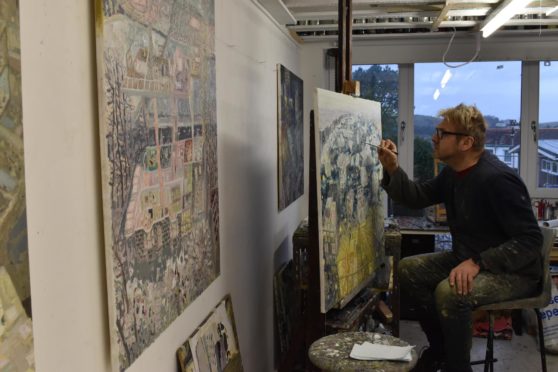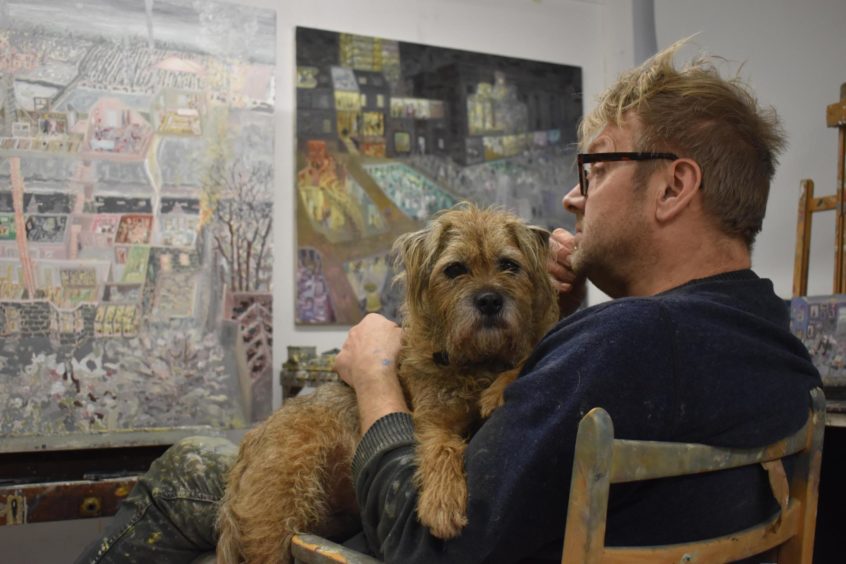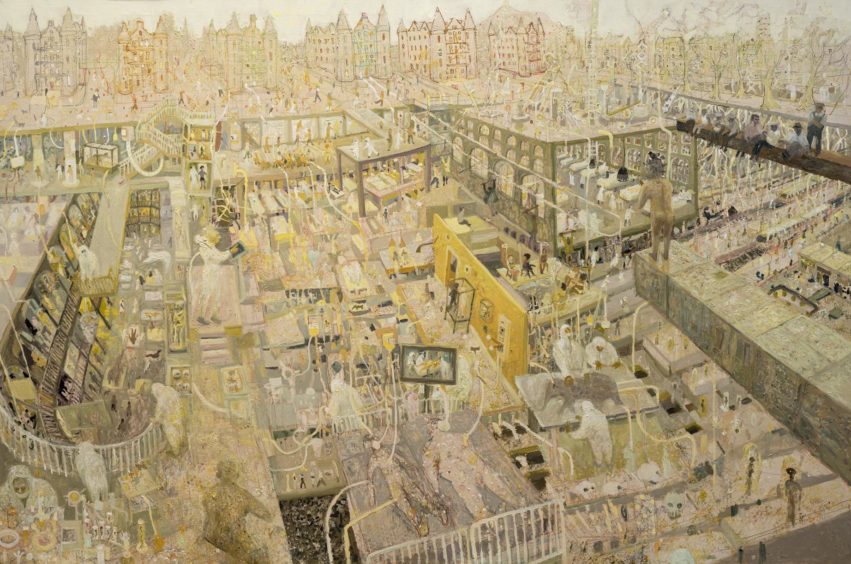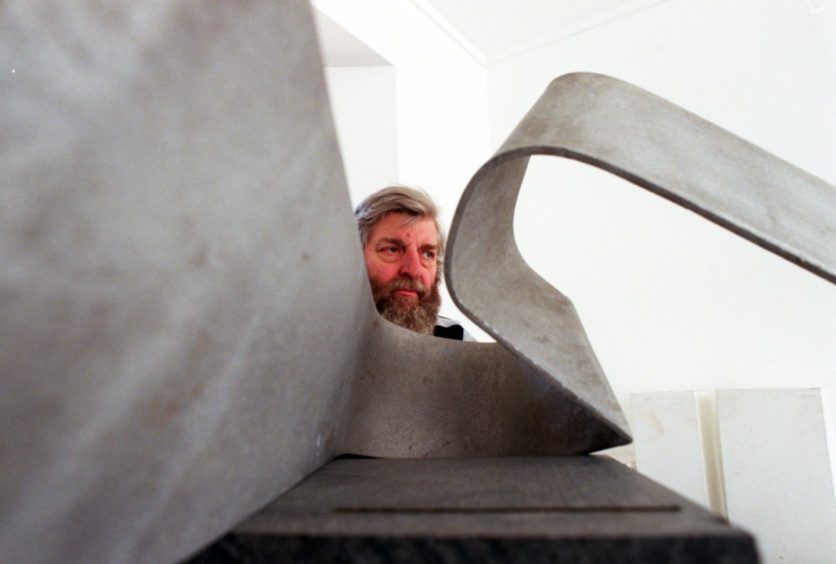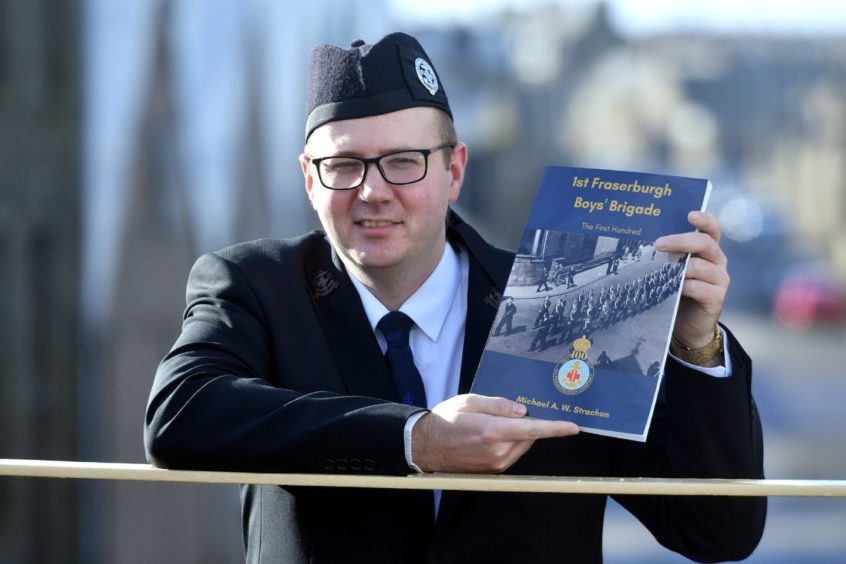During a childhood spent in rural Aberdeenshire and raised by parents invested in the arts, Robbie Bushe dreamt of becoming a comic book illustrator.
Now almost four decades later, the established and award-winning artist is in the running for what could be his biggest accolade to date after being shortlisted for the UK’s most prestigious painting gong, the John Moore Painting Prize.
Born in Liverpool to Glaswegian parents in 1964, Mr Bushe moved to Aberdeen aged five, and then to Tornaveen near Torphins, where he was brought up and educated at Torphins Primary School and Robert Gordon’s College.
He graduated in Painting at Edinburgh College of Art in 1990, before becoming a lecturer at Gray’s School of Art in Aberdeen.
One of four siblings, the idea that Mr Bushe should forge a career in the arts was “never in doubt”, as he followed in not only his late parent’s footsteps but those of elder brother Chris too.
“Both my parents were in the arts,” he said.
“Mr dad Fred Bushe OBE was a sculptor and established the Scottish Sculpture Workshop at Lumsden in 1979.
“My mum was into theatre arts and taught speech and drama at Aberdeen College of Commerce. She won awards for her poetry.
“My interest was encouraged by both my parents. There was never a doubt for me that I would be doing something in the arts.”
As a teenager he was a member of Aberdeen’s Children’s Theatre and Longacre Players, and held his own show at the city’s art centre.
“As a child I always drew cartoons and as a teenager I became very interested in comic strips and graphic novels,” he added.
“But I was never very interested in writing my own stories or illustrating someone else’s.
“What I did like was the form of the storyboard. I like the idea that, in any frame, we are seeing the results of the previous set of frames and the anticipation of what will follow in the next.
“I wanted to be a comic book illustrator, then when I went to art school I got a more traditional paint instruction.
“As a child I would build, demolish and rebuild miniature road networks in the garden based on the routes observed in my 40-mile round trip to school.
“Now these childhood activities have re-emerged as a crucial research methodology for my work.
“My drawings follow the same thought processes as I did as a child creating elaborate environments to add buildings, people, narratives and the occasional 1970s TV science fiction reference.”
Mr Bushe held the positions of head of fine art at the University of Chichester, and lecturer at Kent Institute of Art and Design and Oxford Brookes University, before returning to Scotland in 2006.
He now lives in Oxgangs, Edinburgh, with his wife of 15 years Catharine Davison, also an artist and currently head of painting at Leith School of Art, and their Border terrier Stanley.
Mr Bushe become the coordinator of short courses at Edinburgh College of Art, now part of the University of Edinburgh.
He was also President of Visual Arts Scotland from 2013-2016 and is currently entering his third year as secretary of the Royal Scottish Academy.
As an artist, though, his career has also been well-decorated.
He has won several national awards including most recently the inaugural W Gordon Smith painting prize at the Dovecot Galleries in Edinburgh in 2016.
“Up until now, that was the biggest award I have ever won,” he said.
This month he’s been named as one of the five prize-winning artists short-listed for the first prize at the bi-annual John Moore’s Painting Prize at the Walker Gallery in Liverpool.
“This is the biggest and most prestigious painting prize in the UK and respected internationally,” Mr Bushe added.
“The exhibition was due to open in the summer and the call for entries was this time last year, but because of Covid it kept getting postponed and postponed.
“They created an online version of the award in early December and it’s all been done by social media with a zoom launch held on Thursday.
“There’s some friendly rivalry between the five of us. It’s a big jump from the runner-up prize to the winner with the big prize being a full exhibition of work for the collection.”
Mr Bushe’s entry, a large 158cm x 239cm oil and mixed media on canvas works, entitled The Neanderthal Futures Infirmary, is one of 67 works on display at the Liverpool gallery until June.
“It’s one of a series of four paintings and imagines an old Victorian hospital with a Neanderthal DNA extraction and cloning facility within a complex network of underground bunkers,” Mr Bushe added.
“It’s a look at who the Neanderthals were and how this was a society that existed alongside humans and why one died out.”
Mr Bushe first entered the John Moore’s prize in the mid-1990s when he drove his works to Coatbridge in a van to be considered. He was unsuccessful again online three years ago but this time, his entry stood out from more than 3,000 others.
“This one I was more confident with, as I thought it was a really good piece of work,” he added. “You just never know.”
Shortlisted artists each receive £2,500 while the first prize winner, to be announced on March 4, will receive not only the £25,000 first prize, but also the honour of joining an esteemed list of British painters who have won the prize over the past six decades.
They include David Hockney in 1967, Mary Martin two years later, Lisa Milroy in 1989, Peter Doig in 1993, Keith Coventry in 2010 and Rose Wylie in 2014.
Robbie Bushe’s dad Fred Bushe OBE founded Scottish Sculpture Workshop at Lumsden
It’s little surprise that both Robbie Bushe and his brother Chris have forged successful careers in the arts.
Their late father Fred Bushe was one of Scotland’s most innovative sculptors and his large-scale outdoor creations can be seen in public spaces around the nation.
He studied sculpture at Glasgow School of Art from 1949 to 1953 and spent some time in Nigeria as an education officer during his national service. On his return, he worked for a time as an apprentice welder to finance his art career.
In the mid-1960s, he gained an advanced diploma in art education at Birmingham University’s School of Art and went on to teach sculpture in Birmingham, Liverpool and later at Aberdeen College of Education.
But he was best-known, locally and internationally, for founding the Scottish Sculpture Workshop in an old bakers in Lumsden in 1980.
The first sculpture-specific studio of its kind in the UK, the workshop celebrated its 40th anniversary last year and continues to attract would-be or experienced sculptors from around the world to experiment and exchange ideas in Aberdeenshire.
Among his best-known works are his wooden T-Fold creation which is a proud possession of the Highland Council in Inverness.
He was elected to the Royal Scottish Academy in the 1980s and in 1995 was named OBE in the Queen’s honours list for his services to sculpture.
Mr Bushe also established the biennial Scottish Sculpture Open event at Kildrummy Castle, near Alford, to allow young sculptors to exhibit their creations in wide-open spaces rather than studio or museum backdrop.
The idea inspired further such opens UK-wide. Failing health forced him to retire from the workshop in 1996.
The father-of-five died in Muir of Folwis, aged 78, in 2009, while both sons Chris and Robbie carry on the family’s passion for the arts.
Centenary will be a quiet affair due to Covid but company section still hoping to make trip abroad for special anniversary camp
The company section of 1st Fraserburgh Boys Brigade was the first to be founded in 1921, and later grew to include a junior section around the 1950s and an Anchor section around 40 years ago.
Today the battalion, one of three in the town, boasts around 80 members across the three sections, which meet weekly from September to May in the Old Parish Church Centre.
And should coronavirus restrictions allow, the centenary will create some very special memories for the oldest boys within the group, while younger members will be invited to join a special drill night to commemorate the milestone.
Lieutenant Marc Thomson, captain of 1st Fraserburgh Boys Brigade, said: “We did have more things planned but because of the situation with Covid at the moment, we aren’t able to do then.
“We are giving out centenary badges to all the boys and officers to commemorate the anniversary, though.
“The badges will also be available for other people who collect them to buy too, but the boys will get them first.
“We would have celebrated with a parents night and drill night with all three sections, but we can’t do that because of Covid.”
There’s still high hopes that a planned centenary excursion can still take place later in the year as the group continues its fundraising efforts.
“The company section would have been having a week-long camps in Aviemore in July but because it’s the centenary, we wanted to do an abroad one for a change so have booked to go to PortAventura, in Spain, in the October holidays.
“We are fundraising for that and will continue to do so. The proceeds from the centenary badges will go towards the camp and Michael has kindly said he will donate the proceeds of his book to that too.”
Anyone wishing to purchase a commemorative centenary badge should visit the 1st Fraserburgh Boys Brigade page on Facebook or website.
